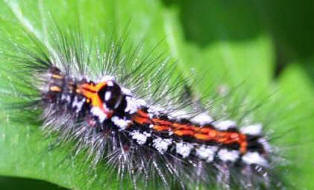Hairy caterpillars from the Yellow tail Moth can cause stripping of the leaves on Raspberries. Typical signs are holes in the raspberry leaves or eaten leaf edges.
The moth is quite attractive – pure silky white – giving its sometimes-used common name of the Swan Moth. As well as the white wings, it has characteristic identifying yellow rear end. This is not so with the larval caterpillar stage which is generally black – with white and orange markings.
This Yellow Tail Moth – or rather its larvae - is not normally considered a severe garden pest, for the caterpillars are only present in small numbers most of the time in the UK. The food of the yellow tail moth caterpillars are plant leaves - in this instance leading to eaten raspberry foliage.
 They can be picked off and destroyed - however wear gloves to do
this for the hairs of this caterpillar can cause irritation. A contact
spray of Bifenthrin will also kill the
caterpillars. Do not use when plants are in flower
for you may also kill pollinating insects such as bees.
They can be picked off and destroyed - however wear gloves to do
this for the hairs of this caterpillar can cause irritation. A contact
spray of Bifenthrin will also kill the
caterpillars. Do not use when plants are in flower
for you may also kill pollinating insects such as bees.
The caterpillars are around 3cm long and brightly coloured orange and black with tufts of hairs protruding from the body - quite attractive! The adult moth is white, but with a slight yellow colouring of the lower part of the body - abdomen.
The life cycle dictates that it is not a year-round pest for the caterpillars tend to pupate in early summer – after firstly feeding on Raspberries and also several other tree and shrub species. The Pupae then further develop or metamorphose into the adult moth which is visible in the evenings during mid-summer – July and August.
.jpg) The
moth in itself is harmless – other than being the parent to be of the
caterpillar pest. The eggs are laid at that time and later over-winter
as eggs to turn into caterpillars mid spring.
The
moth in itself is harmless – other than being the parent to be of the
caterpillar pest. The eggs are laid at that time and later over-winter
as eggs to turn into caterpillars mid spring.
Various similar moths and also the yellow tail moth also feed on several trees or shrubs – normally of Rosaceae family – such as apples, pears, plums and cherries.
When resting, the moth resembles a pitched roof with its sharply domed wing structure.
At the time its curious act of self defense is simply by rolling over on its side – playing dead. Presumably its predators do not eat what is perceived to be dead meat! As with many other moths, it is attracted to a light source and often seen in summer moth traps.
Main Page for Apple Tree Problems